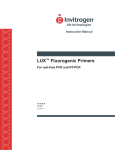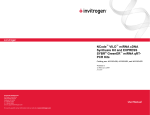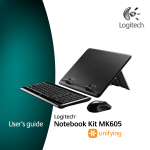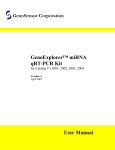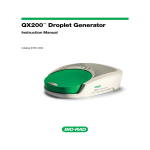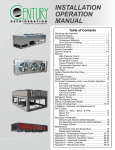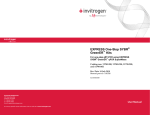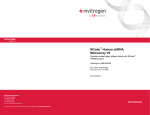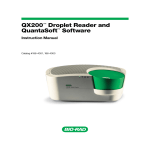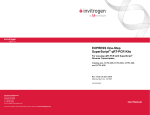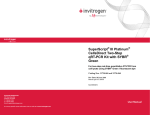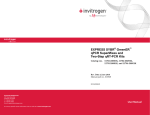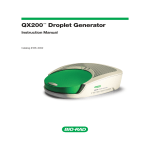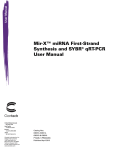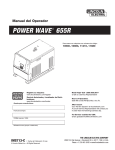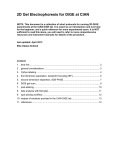Download NCode miRNA First-Strand cDNA Synthesis and qRT
Transcript
USER GUIDE NCode™ miRNA First-Strand cDNA Synthesis and qRT-PCR Kits For polyadenylation and reverse transcription of miRNAs for use in two-step quantitative RT-PCR Catalog numbers MIRC-10, MIRC-50, MIRQ-100, and MIRQER-100 Revision date 19 April 2012 Publication Part number 25-0917 MAN0000563 For Research Use Only. Not for human or animal therapeutic or diagnostic use. ii Table of Contents Kit Contents and Storage.................................................................................... iv Accessory Products ............................................................................................. vi Introduction ............................................................................................................1 Methods............................................................................................. 7 Isolating Total RNA ..............................................................................................7 Poly(A) Tailing of miRNA ...................................................................................9 First-Strand cDNA Synthesis.............................................................................11 qPCR — Guidelines and Recommendations ..................................................13 qPCR Using SYBR® Green SuperMix ...............................................................17 qPCR Using SYBR® GreenER™ SuperMix .......................................................19 Appendix ......................................................................................... 21 Troubleshooting ...................................................................................................21 Technical Support ................................................................................................23 Purchaser Notification ........................................................................................24 References .............................................................................................................25 iii Kit Contents and Storage Shipping and Storage Kit components are shipped on dry ice and should be stored at –20ºC, except SYBR® GreenER™ qPCR SuperMix Universal (provided with MIRQER-100), which may be stored at either 4ºC or –20ºC. MIRC-10 and MIRC-50: The NCode™ miRNA First-Strand Kit Configurations cDNA Synthesis Kits include components for polyadenylation and cDNA synthesis, plus the Universal qPCR Primer. Other qPCR reagents must be ordered separately. MIRQ-100: The NCode™ SYBR® Green miRNA qRT-PCR Kit includes the components provided with MIRC-10, plus Platinum® SYBR® Green qPCR SuperMix-UDG. MIRQER-100: The NCode™ SYBR® GreenER miRNA qRTPCR Kit includes the components provided with MIRC-10, plus SYBR® GreenER™ qPCR SuperMix Universal. Cat. no. MIRC-10 MIRC-50 MIRQ-100 MIRQER-100 NCode™ miRNA FirstStrand cDNA Synthesis Kits Number of Reactions Polyadenylation cDNA Synthesis qPCR 10 20 — 50 100 — 10 20 100 10 20 100 The following reagents and amounts are provided: Component 5X miRNA Reaction Buffer 25 mM MnCl2 10 mM ATP Poly A Polymerase Annealing Buffer SuperScript® III RT/RNaseOut™ Enzyme Mix 2X First-Strand Reaction Buffer (includes MgCl2 and dNTPs) Universal RT Primer (25 μM) Universal qPCR Primer (10 μM) DEPC-treated water MIRC-10 MIRC-50 50 μL 250 μL 50 μL 250 μL 10 μL 250 μL 8 μL 40 μL 20 μL 100 μL 40 μL 200 μL 200 μL 60 μL 250 μL 2 mL 1 mL 300 μL 1.25 mL 2 × 2 mL Continued on next page iv Kit Contents and Storage, continued Platinum® SYBR® Green qPCR SuperMixUDG MIRQ-100 includes the components provided with MIRC-10, plus the following: Component Platinum® SYBR® Green qPCR SuperMix-UDG 50-mM Magnesium Chloride (MgCl2) 20X UltraPure™ BSA (Bovine Serum Albumin) ROX™ Reference Dye Amount 2 × 1.25 mL 1 mL 300 μL 100 μL SYBR® GreenER™ qPCR SuperMix Universal MIRQER-100 includes the components provided with MIRC-10, plus the following: Important Minimize exposure of SYBR® Green and SYBR® GreenER™ reagents and ROX™ Reference Dye to direct light, to avoid loss of fluorescent signal intensity. Note Each polyadenylation reaction provides enough tailed RNA for six cDNA synthesis reactions, and each cDNA synthesis reaction provides enough cDNA for multiple qPCR reactions. Product Use For Research Use Only. Not intended for any human or animal diagnostic or therapeutic uses. Component SYBR® GreenER™ qPCR SuperMix Universal ROX™ Reference Dye Amount 2 × 1.25 mL 100 μL v Accessory Products Additional Products The NCode™ system is an integrated miRNA expression profiling system that includes miRNA isolation, amplification, purification, quantification, labeling, and array hybridization components. Additional products are available separately from Life Technologies. Ordering information is provided below. For more information, visit our website at www.lifetechnologies.com or contact Technical Support (page 23). Product TRIzol® Reagent Size Cat. no. 100 mL 200 mL 15596-026 15596-018 RNase AWAY® Reagent 250 mL 10328-011 Custom Primers visit www.lifetechnologies.com/oligos Platinum® SYBR® Green qPCR SuperMix-UDG 100 reactions 500 reactions 11733-038 11733-046 SYBR® GreenER™ qPCR SuperMix for ABI PRISM® 100 reactions 500 reactions 11760-100 11760-500 SYBR® GreenER™ qPCR SuperMix for iCycler® Instrument 100 reactions 500 reactions 11761-100 11761-500 SYBR® GreenER™ qPCR SuperMix Universal 100 reactions 500 reactions 11762-100 11762-500 RNaseOUT™ Recombinant Ribonuclease Inhibitor 5,000 units 10777-019 Fluorescein NIST-Traceable Standard (50 μM) 5 × 1 mL F36915 Quant-iT™ Ribogreen® RNA Assay Kit 200–2,000 cuvette assays R-11490 RediPlate™ 96 Ribogreen® RNA Quantitation Kit 96-well plate (8 × 12 strip wells) R-32700 PureLink® miRNA Isolation Kit 25 preps K1570-01 NCode™ miRNA Amplification System 20 reactions MIRAS-20 NCode miRNA Labeling System 20 labeling and hybridization reactions MIRLS-20 NCode™ Multi-Species miRNA Microarray V2 5 slides MIRA2-05 NCode™ Multi-Species miRNA Microarray Control V2 10 μL MIRAC2-01 NCode™ Multi-Species miRNA Microarray Probe Set V2 3 × 384-well plates / 500 pmol per well MIRMPS2-01 ™ vi Introduction System Overview The NCode™ miRNA First-Strand cDNA Synthesis Kits and qRT-PCR Kits provide qualified reagents for the polyadenylation of microRNAs (miRNAs) from total RNA and synthesis of first-strand cDNA from the tailed miRNAs for use in real-time quantitative PCR (qPCR). These kits have been optimized for the detection and quantification of miRNA from 10 ng to 2.5 μg of total RNA using a SYBR® Green or SYBR® GreenER™ detection platform. Isolation of small RNAs is typically not required, though it may enhance detection of some rare miRNAs. SuperScript® III Reverse Transcriptase (RT) in the cDNA synthesis reaction ensures high specificity and high yields of cDNA from small amounts of starting material. Platinum® SYBR® Green qPCR SuperMix-UDG (included with catalog no. MIRQ-100) ensures optimal qPCR performance using SYBR® Green I dye, with excellent sensitivity and a linear dose response over a wide range of target concentrations. SYBR® GreenER™ qPCR SuperMix Universal (included with catalog no. MIRQER-100) contains a novel fluorescent double-stranded DNA (dsDNA) binding dye for both higher sensitivity and lower PCR inhibition than SYBR® Green I dye. It can be used on real-time PCR instruments calibrated for SYBR® Green I dye without any change of filters or settings. Workflow Overview Following isolation of total RNA, all the miRNAs in the sample are polyadenlyated using poly A polymerase and ATP. Following polyadenylation, SuperScript® III RT and a specially-designed Universal RT Primer are used to synthesize cDNA from the tailed miRNA population. The first-strand cDNA is ready for analysis in qPCR using SYBR® Green or SYBR® GreenER™ detection reagents, the Universal qPCR Primer provided in the kit, and a forward primer designed by the user that targets the specific miRNA sequence of interest (see page 3 for design guidelines). Continued on next page 1 Introduction, continued Workflow Diagram Advantages of the Kit The NCode™ kits have the following advantages: • Starting material can range from 10 ng to 2.5 μg of total RNA; enrichment of miRNAs is typically not required • No proprietary primers or primer-probe assays required for qPCR; you can design your own primers for any miRNA sequence from any species • Can discriminate between miRNAs that differ by a single nucleotide, for profiling closely related templates • Catalog nos. MIRC-10 and MIRC-50: The Universal qPCR Primer included in the kit gives you the flexibility to order your qPCR detection reagents separately • Catalog no. MIRQ-100: Platinum® SYBR® Green qPCR SuperMix-UDG included in the kit ensures high sensitivity and performance in qPCR using SYBR® Green I fluorescent dye • Catalog no. MIRQER-100: SYBR® GreenER™ qPCR SuperMix Universal included in the kit ensures optimal sensitivity and performance in qPCR using a novel fluorescent dsDNA binding dye Continued on next page 2 Introduction, continued Forward Primer Design for qPCR The forward primer in qPCR is specific for the miRNA sequence of interest, and must be ordered separately by the user. As a starting point, we recommend ordering a DNA oligo that is identical to the entire mature miRNA sequence. (Note that this is the complement of the reverse-transcribed miRNA sequence from the cDNA synthesis reaction.) For example, note the following primer design for the miRNA hsa-miR-124a: miRNA sequence uuaaggcacgcggugaaugcca Primer sequence ttaaggcacgcggtgaatgcca In most cases, using an oligo that is identical to the entire mature miRNA is optimal. In some cases, truncating the primer sequence may be necessary (see page 14). Note that the Universal qPCR Primer supplied with each kit is used as the reverse primer in qPCR. Visit www.lifetechnologies.com/oligos to order the miRNAspecific forward primer from Life Technologies. SuperScript® III RT SuperScript® III Reverse Transcriptase is an engineered version of M-MLV RT with reduced RNase H activity and increased thermal stability (Gerard et al., 1986; Kotewicz et al., 1985). The enzyme can be used to synthesize first-strand cDNA at temperatures up to 55ºC, providing increased specificity, higher yields of cDNA, and more full-length product than other reverse transcriptases. Platinum® SYBR® Green qPCR SuperMixUDG Platinum® SYBR® Green qPCR SuperMix-UDG is a reaction mix containing all components, except primers, for the amplification and detection of DNA in qPCR (Ishiguro et al., 1995; Wittwer et al., 1997). It combines the hot-start technology of Platinum® Taq DNA polymerase with integrated UDG carryover prevention and SYBR® Green I fluorescent dye. The SuperMix is supplied at a 2X concentration and contains Platinum® Taq DNA polymerase, SYBR® Green I dye, MgCl2, dNTPs (with dUTP instead of dTTP), uracil DNA glycosylase (UDG), and stabilizers. See the insert provided with Platinum® SYBR® Green qPCR SuperMix-UDG for more details. Continued on next page 3 Introduction, continued SYBR® GreenER™ qPCR SuperMix Universal SYBR® GreenER™ qPCR SuperMix Universal is a ready-to-use cocktail containing all components, except primers and template, for the amplification and detection of DNA in qPCR. It combines a chemically modified “hot-start” version of Taq DNA polymerase with integrated uracil DNA glycosylase (UDG) carryover prevention technology and a novel fluorescent dye to deliver excellent sensitivity in the quantification of target sequences, with a linear dose response over a wide range of target concentrations. SYBR® GreenER™ qPCR SuperMix Universal is supplied at a 2X concentration and contains hot-start Taq DNA polymerase, SYBR® GreenER™ fluorescent dye, MgCl2, dNTPs (with dUTP instead of dTTP), UDG, and stabilizers. MicroRNAs MicroRNAs (miRNAs) are a recently discovered class of small, ~19–23-nucleotide non-coding RNA molecules. They are cleaved from hairpin precursors and are believed play an important role in translation regulation of target mRNAs by binding to partially complementary sites in the 3´ untranslated regions (UTRs) of the message (Lim, 2003). Several groups have hypothesized that there may be up to 20,000 non-coding RNAs that contribute to eukaryotic complexity (Bentwich et al., 2005; Imanishi et al., 2004; Okazaki et al., 2002). Though hundreds of miRNAs have been discovered, little is known about their cellular function. They have been implicated in regulation of developmental timing and pattern formation (Lagos-Quintana et al., 2001), restriction of differentiation potential (Nakahara & Carthew, 2004), regulation of insulin secretion (Stark et al., 2003), and genomic rearrangements (John et al., 2004). Several unique physical attributes of miRNAs—including their small size, lack of poly-adenylated tails, and tendency to bind their mRNA targets with imperfect sequence homology—have made them elusive and challenging to study. In addition, strong conservation between miRNA family members means that any detection technology must be able to distinguish between ~22-base sequences that differ by only 1–2 nucleotides. Recent advances in microarray and qPCR detection have enabled the use of these technologies for miRNA screening. Continued on next page 4 Introduction, continued Other Products in the NCode™ System The NCode™ SYBR® Green miRNA qRT-PCR Kit and NCode™ miRNA First-Strand cDNA Synthesis Kit were designed and developed in conjunction with the following Life Technologies products (for ordering information, see page vi): • The NCode™ miRNA Labeling System is a robust and efficient system for labeling and hybridizing miRNA to NCode™ microarrays for expression profiling analysis. Using this kit, you ligate a short, highly specific tag sequence to each miRNA, and then hybridize highly fluorescent Alexa Fluor® dye molecules to the tagged miRNA. The high specificity of the binding sequence and high fluorescence of the dye molecules ensure maximum signal and strong signal correlations. • The NCode™ miRNA Amplification System is a robust system for amplifying senseRNA molecules from minute quantities of miRNA. The system provides consistent and accurate ≥1000-fold amplification while preserving the relative abundance of the miRNA sequences in the original sample, allowing you to compare relative quantities across experiments. The resulting amplified miRNA is in the sense orientation, for direct compatibility with NCode™ microarray probe sequences. • The NCode™ Multi-Species miRNA Microarray V2 consists of 5 Corning® Epoxide-Coated Glass Slides, each printed with optimized probe sequences targeting all of the known mature miRNAs in miRBase, Release 9.0 (http://microrna.sanger.ac.uk), for human, mouse, rat, D. melanogaster, C. elegans, and Zebrafish. The probes were designed using an algorithm that generates miRNA sequences with enhanced hybridization properties (Goff et al., 2005). Each slide comes blocked and ready to use. • The NCode™ Multi-Species miRNA Microarray Probe Set V2 includes the probe sequences provided on the microarray listed above, dried down in 384-well plates at 500 pmoles per well and ready for printing on standard DNA microarray surfaces. • The NCode™ Multi-Species miRNA Microarray Control V2 is a synthetic 22-nucleotide miRNA sequence that has been designed and screened as a positive control for use with NCode™ system. Continued on next page 5 Introduction, continued Materials Supplied by the User The following materials are required for use with these kits: • 10 ng to 2.5 μg of total RNA • Forward PCR primer designed for the miRNA target of interest (see page 3 for design guidelines) • 1 mM Tris, pH 8.0 • Microcentrifuge • Heat block, water bath, and/or thermal cycler • RNase-free pipette tips • 1.5-mL RNase-free microcentrifuge tubes • Disposable gloves • Ice • Optional: RNaseOUT™ Recombinant Ribonuclease Inhibitor, for the negative RT control • qPCR instrument • Appropriate PCR plates/tubes for instrument Additional materials required for catalog nos. MIRC-10 or MIRC-50. • 6 qPCR reagents that include SYBR® Green or SYBR® GreenER™ binding dyes (see page vi) Methods Isolating Total RNA Introduction High quality total RNA is essential for qRT-PCR analysis. In this step, you obtain total RNA or isolate it from a sample. Note about Isolating Small RNA Molecules Isolating small RNA molecules from total RNA prior to use of this kit is not required, and may in fact limit the detection of some miRNAs in qRT-PCR. However, for extremely lowabundance miRNAs, multiple total RNA samples (~10 μg each) may be pooled and the miRNA may be enriched from the pooled sample for detection in qRT-PCR. The PureLink® miRNA Isolation Kit is available for this purpose (see page vi). General Handling of RNA When working with RNA: • Use disposable, individually wrapped, sterile plasticware. • Use aerosol resistant pipette tips for all procedures. • Use only sterile, new pipette tips and microcentrifuge tubes. • Wear latex gloves while handling reagents and RNA samples to prevent RNase contamination from the surface of the skin. • Use proper microbiological aseptic technique when working with RNA. • Dedicate a separate set of pipettes, buffers, and enzymes for RNA work. • Use RNase-free microcentrifuge tubes. If it is necessary to decontaminate untreated tubes, soak the tubes overnight in a 0.01% (v/v) aqueous solution of diethylpyrocarbonate (DEPC), rinse the tubes with sterile distilled water, and autoclave the tubes. You can use RNase AWAY® Reagent, a non-toxic solution available from Life Technologies, to remove RNase contamination from surfaces. For further information on controlling RNase contamination, see (Ausubel et al., 1994; Sambrook et al., 1989). Continued on next page 7 Isolating Total RNA, continued Isolating Total RNA To isolate total RNA, we recommend TRIzol® Reagent (Cat. nos. 15596-026 and 15596-018). Ordering information is provided on page vi. The PureLink® Micro-to-Midi™ Total RNA Purification System (Cat. no. 12183-018) or PureLink® 96 Total RNA Purification Kit (Cat. no. 12173-011) may also be used. Amount of Total RNA Required 8 Use 10 ng to 2.5 μg of total RNA, depending on the abundance of your miRNA targets. The optimal sample range is 100 ng to 1 μg of total RNA. Poly(A) Tailing of miRNA Introduction In this step, you add a poly(A) tail to the miRNA in your total RNA sample. Required Materials The following materials are supplied in the NCode™ miRNA First-Strand cDNA Synthesis Kit: • 5X miRNA Reaction Buffer • 25 mM MnCl2 • 10 mM ATP • Poly A Polymerase (PAP) • DEPC-treated water The following materials are supplied by the user: Important • 10 ng to 2.5 μg of total RNA • 1 mM Tris, pH 8.0 • Microcentrifuge • Heat block or water bath set at 37°C • RNase-free pipette tips • 1.5-mL RNase-free microcentrifuge tubes The following reaction uses the manganese chloride (MnCl2) supplied in the First-Strand cDNA Synthesis Kit, not the magnesium chloride (MgCl2) supplied with Platinum® SYBR® Green qPCR SuperMix-UDG (included with cat. no. MIRQ-100). Be careful to select the vial of MnCl2 for use in the following reaction. Continued on next page 9 Poly(A) Tailing of miRNA, continued Note Poly(A) Tailing Procedure Each reaction requires 0.5 μL of Poly A Polymerase. To avoid pipetting 0.5 μL of enzyme, do one of the following: • For multiple reactions, prepare a master mix of all components except RNA, including the equivalent of 0.5 μL of enzyme per reaction • For a single reaction, dilute the Poly A Polymerase 1:1 with DEPC-treated water. (Dilute 1 μL of Poly A Polymerase with 1 μL of DEPC-treated water, and use 1 μL of the dilution per reaction.) Use the following procedure to add poly(A) tails to the total RNA: 1. Based on the quantity of total RNA, dilute a volume of 10 mM ATP in 1 mM Tris (pH 8.0) according to the following formula: ATP dilution factor = 5000/____ ng of total RNA Example: If you are starting with 100 ng of total RNA, the ATP dilution factor is 5000/100 ng = 50. Dilute the ATP 1:50 by adding 1 μL of 10 mM ATP to 49 μL of 1 mM Tris, pH 8.0. 2. Add the following at room temperature to the tube of total RNA. For multiple reactions, prepare a master mix of common components to enable accurate pipetting. Component RNA 5X miRNA Reaction Buffer 25 mM MnCl2 Diluted ATP (from Step 1) Poly A Polymerase (see Note above) DEPC-treated water Volume x μL 5 μL 2.5 μL 1 μL 0.5 μL to 25 μL 3. Mix gently and centrifuge the tube briefly to collect the contents. 4. Incubate the tube in a heat block or water bath at 37°C for 15 minutes. After incubation, proceed immediately to First-Strand cDNA Synthesis, next page. 10 First-Strand cDNA Synthesis Introduction In this step, you reverse transcribe the polyadenylated miRNA to generate first-strand cDNA. Note The following reaction uses 4 μL of the 25-μL poly(A) tailing reaction from Step 4, previous page. Each poly(A) tailing reaction provides enough polyadenylated miRNA for up to six cDNA synthesis reactions. Required Materials The following materials are supplied in the NCode™ miRNA First-Strand cDNA Synthesis Kit: • Annealing Buffer • Universal RT Primer (25 μM) • 2X First-Strand Reaction Buffer • SuperScript® III RT/RNaseOUT™ Enzyme Mix The following materials are provided by the user: • Thermal cycler or water bath preheated to 65ºC • Microcentrifuge • Ice • 1.5-mL RNase-free microcentrifuge tubes • RNase-free pipette tips • Optional: RNaseOUT™ Recombinant Ribonuclease Inhibitor, for the negative RT control Continued on next page 11 First-Strand cDNA Synthesis, continued First-Strand cDNA Synthesis Use the following procedure to reverse transcribe the polyadenylated miRNA from Step 4, page 10: 1. Add the following to an RNase-free microcentrifuge tube: Component Polyadenylated RNA from Step 4, page 10 Annealing Buffer Universal RT Primer (25 μM) Total volume Amount 4 μL 1 μL 3 μL 8 μL 2. Incubate the tube at 65ºC for 5 minutes. 3. Place the tube on ice for 1 minute. 4. Add the following to the tube, for a final volume of 20 μL: Component Amount 2X First-Strand Reaction Mix 10 μL SuperScript® III RT/RNaseOUT™ Enzyme Mix* 2 μL *For negative RT controls, use 1 μL of sterile, distilled water and 1 μL of RNaseOUT™ Recombinant Ribonuclease Inhibitor instead of the Enzyme Mix. 5. Spin the tube briefly to collect the contents. 6. Transfer the tube to a thermal cycler preheated to 50ºC and incubate for 50 minutes. 7. Incubate at 85ºC for 5 minutes to stop the reaction. Chill the reaction on ice. Store aliquots at –20ºC or proceed directly to qPCR. 12 qPCR — Guidelines and Recommendations Introduction This section provides guidelines and recommendations for qPCR using either Platinum® SYBR® Green qPCR SuperMixUDG or SYBR® GreenER™ qPCR SuperMix Universal. Required Materials The following materials are provided in all kits: • Universal qPCR Primer The following materials are provided with MIRQ-100: • • Platinum® SYBR® Green qPCR SuperMix-UDG ROX™ Reference Dye The following materials are provided with MIRQER-100: • • SYBR® GreenER™ qPCR SuperMix Universal ROX™ Reference Dye The following materials are provided by the user: • Forward PCR primer designed for miRNA of interest (see next page for detailed design guidelines) • qPCR instrument • Appropriate PCR plates/tubes for instrument • • RNase-free pipette tips cDNA from Step 7, page 12 Note Minimize exposure of ROX™ Reference Dye and the SYBR® Green and SYBR® GreenER™ SuperMixes to direct light. Exposure to direct light for an extended period of time may result in loss of fluorescent signal intensity. Ordering qPCR Reagents Separately The NCode™ miRNA First-Strand cDNA Synthesis Kits were designed and developed for use with SYBR® Green and SYBR® GreenER™ SuperMixes. If you are using catalog nos. MIRC-10 or MIRC-50, you can order these SuperMixes separately. See page vi for ordering information. Continued on next page 13 qPCR — Guidelines and Recommendations, continued qPCR Primers Reverse primer: The Universal qPCR Primer supplied with each kit is used as the reverse primer in qPCR. It is supplied at 10 μM and used at a final concentration of 200 nM. Forward primer: The forward primer in qPCR is specific for the miRNA sequence of interest, and must be ordered separately by the user. As a starting point, we recommend ordering a DNA oligo that is identical to the entire mature miRNA sequence. (Note that this is the complement of the reverse-transcribed miRNA sequence from the cDNA synthesis reaction.) For example, note the following primer design for the miRNA hsa-miR-124a: miRNA sequence uuaaggcacgcggugaaugcca Primer sequence ttaaggcacgcggtgaatgcca In most cases, using an oligo that is identical to the entire mature miRNA is optimal. In some cases, truncating the primer sequence may be necessary (see below). Visit www.lifetechnologies.com/oligos to order the miRNAspecific forward primer from Life Technologies. A final primer concentration of 200 nM is effective for most reactions. Truncating the Forward Primer We have seen optimal results with primers that have a melting temperature (Tm) of 55–68ºC. For some GC-rich miRNA sequences, it may be necessary to design a forward primer that is truncated by 3–4 bases on the 3´ end to reduce the Tm. If you detect a higher-than-average amount of primer dimers in your qPCR, or if the miRNA sequence is GC-rich, try designing a truncated forward primer. Continued on next page 14 qPCR — Guidelines and Recommendations, continued Instrument Settings Platinum® SYBR® Green qPCR SuperMix-UDG and SYBR® GreenER™ qPCR SuperMix Universal can be used with a variety of real-time instruments, including but not limited to: • • Applied Biosystems® 7000, 7700, and 7900HT Applied Biosystems® 7300 and 7500 Real-Time PCR Systems • Applied Biosystems® GeneAmp® 5700 • Bio-Rad iCycler® Instrument • Agilent Mx3000P®, Mx3005P®, and Mx4000 • Qiagen Research Rotor-Gene® System • Bio-Rad DNA Engine Opticon®, Opticon™ 2, and Chromo4™ Real-Time Detector • Cepheid SmartCycler® Instrument Optimal cycling conditions will vary with different instruments. For additional information, visit www.lifetechnologies.com/qpcr. ROX™ Reference Dye ROX™ Reference Dye can be included in the reaction to normalize the fluorescent reporter signal, for instruments that are compatible with that option. ROX™ Reference Dye is supplied with both Platinum® SYBR® Green qPCR SuperMixUDG and SYBR® GreenER™ qPCR SuperMix Universal at a 25 μM concentration. It is composed of a glycine conjugate of 5-carboxy-X-rhodamine, succinimidyl ester in 20 mM TrisHCl (pH 8.4), 0.1 mM EDTA, and 0.01% Tween® 20. Use the following table to determine the amount of ROX™ Reference Dye to use with a particular instrument: Instrument Applied Biosystems® 7000, 7300 7700, and 7900HT Applied Biosystems® 7500; Agilent Mx3000®, Mx3005P®, and Mx4000 Amount of ROX™ per 50-μL reaction Final ROX™ Conc. 1.0 μL 500 nM 0.1 μL* 50 nM *To accurately pipet 0.1 μL per reaction, we recommend diluting ROX™ Reference Dye 1:10 immediately before use and use 1 μL of the dilution. Continued on next page 15 qPCR — Guidelines and Recommendations, continued Melting Curve Analysis Melting curve analysis should always be performed after qPCR to identify the presence of primer dimers and analyze the specificity of the reaction. Melting curve analysis can identify primer dimers by their lower annealing temperature compared to that of the amplicon. The presence of primer dimers decreases PCR efficiency and obscures analysis and determination of cycle thresholds. For more information, visit www.lifetechnologies.com/qpcr. Fluorescein The Bio-Rad iCycler® requires the use of fluorescein as a reference dye to normalize the fluorescent reporter signal with SYBR® Green and SYBR® GreenER™ SuperMixes. Fluorescein NIST-Traceable Standard is available from Life Technologies as a 50-μM solution (see page vi). (If you are ordering a SYBR® GreenER™ SuperMix as a separate component, you can order SYBR® GreenER™ qPCR SuperMix for iCycler® instrument, which includes fluorescein in the mix; see page vi.) We recommend using a final concentration of 50 nM as a general starting point in qPCR. Optimal results may require a titration between 10 and 100 nM. 16 qPCR Using SYBR® Green SuperMix Introduction This section provides a general protocol for qPCR on Applied Biosystems real-time instruments using Platinum® SYBR® Green qPCR SuperMix-UDG. Note • Since PCR is a powerful technique capable of amplifying trace amounts of DNA, all appropriate precautions should be taken to avoid cross-contamination. • For multiple reactions, prepare a master mix of common components (with a ~10% overage for accurate pipetting), add the appropriate volume to each tube or plate well, and then add the unique reaction components (e.g., template). Preparation of a master mix is strongly recommended in qPCR to reduce pipetting errors. • Note the lower amount of ROX™ Reference Dye required for the Applied Biosystems® 7500. Template Dilution Dilute the cDNA 1:10 as described on the next page and use 5 μL of the dilution in a 50-μL qPCR (i.e., 1% v/v cDNA). Note on Annealing Temperature The following cycling program recommends an annealing temperature of 60ºC. Raising the annealing temperature to 63–65ºC may result in better discrimination of closely related miRNA sequences, but with a slight loss in sensitivity. Cycling Program The cycling program below is designed for Applied Biosystems real-time instruments. This program may also be used as a starting point for other real-time instruments. Standard Cycling Program for Applied Biosystems® Instruments 50ºC for 2 minutes (UDG incubation) 95ºC for 2 minutes 40 cycles of: 95ºC, 15 seconds 60ºC*, 30 seconds (60 seconds for the 7900HT) Fast Cycling Program (for the Applied Biosystems® 7500 in Fast Mode) Select Fast Mode on Thermal Profile tab 50ºC for 2 minutes (UDG incubation) 95ºC for 2 minutes 40 cycles of: 95ºC, 3 seconds 60ºC*, 30 seconds Melting curve analysis: See instrument documentation *See Note on Annealing Temperature above. Continued on next page 17 qPCR Using SYBR® Green SuperMix, continued qPCR Protocol Follow the steps below to perform qPCR using Platinum® SYBR® Green qPCR SuperMix-UDG. Volumes for a single 50-μL reaction are listed. Volumes can be scaled as needed (e.g., scaled down to a 20-μL reaction volume for 384-well plates). 1. Dilute the cDNA (from Step 7, page 12) 1:10 in DEPCtreated water. Use 5 μL of diluted cDNA per 50-μL reaction (i.e., 1% v/v cDNA). 2. Add the following components to each DNase/RNasefree PCR tube or plate well. Component Amount Platinum® SYBR® Green qPCR SuperMix-UDG 25 μL (1X final conc.) Forward primer, 10 μM 1 μL (200 nM final conc) Universal qPCR Primer, 10 μM 1 μL (200 nM final conc) ROX™ Reference Dye (optional) 1 μL/0.1 μL (see page 15) Template (diluted 1:10, Step 1) 5 μL (1% v/v cDNA) DEPC-treated water to 50 μL 3. Cap or seal the tube/plate, and gently mix. Make sure that all components are at the bottom of the tube/plate. Centrifuge briefly if needed. 4. Place reactions in a preheated real-time instrument programmed as described on the previous page. Run the program. After cycling, hold the reaction at 4ºC until further analysis. Analyze the cycle threshold (Ct) values, slope of the standard curve, Y-intercept, and correlation coefficient (R2) for your qPCR experiments using the software provided with your instrument. 18 qPCR Using SYBR® GreenER™ SuperMix Introduction This section provides a general protocol for qPCR on Applied Biosystems® real-time instruments using SYBR® GreenER™ qPCR SuperMix Universal. Note • Since PCR is a powerful technique capable of amplifying trace amounts of DNA, all appropriate precautions should be taken to avoid cross-contamination. • For multiple reactions, prepare a master mix of common components (with a ~10% overage for accurate pipetting), add the appropriate volume to each tube or plate well, and then add the unique reaction components (e.g., template). Preparation of a master mix is strongly recommended in qPCR to reduce pipetting errors. • Note the lower amount of ROX™ Reference Dye required for the Applied Biosystems® 7500. Template Volume Dilute the cDNA 1:10 as described on the next page and use 5 μL of the dilution in a 50-μL qPCR (i.e., 1% v/v cDNA). Note on Annealing Temperature The following cycling program recommends an annealing temperature of 57ºC. Raising the annealing temperature to 59ºC may result in better discrimination of closely related miRNA sequences, but with a slight loss in sensitivity. DNA Polymerase Activation The hot-start DNA polymerase used in SYBR® GreenER™ qPCR SuperMix is activated during the 10-minute incubation at 95°C before PCR cycling. Continued on next page 19 qPCR Using SYBR® GreenER™ SuperMix, continued qPCR Protocol Follow the steps below to perform qPCR using SYBR® GreenER™ qPCR SuperMix Universal. Volumes for a single 50-μL reaction are listed. Volumes can be scaled as needed (e.g., scaled down to a 20-μL reaction volume for 384-well plates). 1. Program the real-time instrument as shown below. The cycling program is designed for Applied Biosystems® instruments. It may also be used as a starting point for other real-time instruments. 50ºC for 2 minutes (UDG incubation) 95ºC for 10 minutes (UDG inactivation and DNA polymerase activation) 40 cycles of: 95ºC, 15 seconds 57ºC*, 60 seconds Melting curve analysis: See instrument documentation *See Note on Annealing Temperature, previous page. 2. Dilute the cDNA (from Step 7, page 12) 1:10 in DEPCtreated water. Use 5 μL of diluted cDNA per 50-μL reaction (i.e., 1% v/v cDNA). 3. Add the following components to each DNase/RNasefree PCR tube or plate well. Component Amount SYBR® GreenER™ qPCR SuperMix 25 μL (1X final conc.) Forward primer, 10 μM 1 μL (200 nM final conc.) Universal qPCR Primer, 10 μM 1 μL (200 nM final conc.) ROX™ Reference Dye (optional) 1 μL/0.1 μL (see page 15) Template (diluted 1:10, Step 2) 5 μL (1% v/v cDNA) DEPC-treated water to 50 μL 4. Cap or seal the tube/plate, and gently mix. Make sure that all components are at the bottom of the tube/plate. Centrifuge briefly if needed. 5. Place reactions in a preheated real-time instrument programmed as described on the previous page. Run the program. After cycling, hold the reaction at 4ºC until further analysis. Analyze the cycle threshold (Ct) values, slope of the standard curve, Y-intercept, and correlation coefficient (R2) for your qPCR experiments using the software provided with your instrument. 20 Appendix Troubleshooting Problem Possible Cause Suggested Solution Signals are present in no-template controls, and/or multiple peaks are present in the melting curve graph Template or reagents are contaminated by nucleic acids (DNA, cDNA) • Use melting curve analysis and/or run the PCR products on a 4% agarose gel after the reaction to identify contaminants. Primer dimers or other nonspecific products are present • Take standard precautions to avoid contamination when preparing your PCR reactions. Ideally, amplification reactions should be assembled in a DNA-free environment. We recommend using aerosolresistant barrier tips. • Primer contamination or degraded primers can lead to artifacts. Check the purity of your primers by gel electrophoresis. • Be sure to dilute the cDNA 1:10 in DEPCtreated water before qPCR, as specified in the protocol. Use 5 μL of diluted cDNA per 50-μL reaction (i.e., 1% v/v cDNA). • Increasing the annealing temperature in the qPCR may increase the specificity in the case of miRNA sequences that differ by only a few bases (note that the sensitivity of the reaction may decrease). No amplification curve appears on the qPCR graph There is no PCR product Run the reaction on a gel to determine whether PCR worked. Then proceed to the troubleshooting steps below. No PCR product is evident, either in the qPCR graph or on a gel The protocol was not followed correctly Verify that all steps have been followed and the correct reagents, dilutions, volumes, and cycling parameters have been used. Template contains Purify or re-purify your template. inhibitors, nucleases, or proteases, or has otherwise been degraded. Primer design is suboptimal Verify your primer selection. We recommend using validated pre-designed primers or design primers using dedicated software programs or primer databases. Continued on next page 21 Troubleshooting, continued Problem Possible Cause Suggested Solution PCR product is evident in the gel, but not on the qPCR graph qPCR instrument settings are incorrect Confirm that you are using the correct instrument settings (dye selection, reference dye, filters, acquisition points, etc.). Problems with your specific qPCR instrument See your instrument manual for tips and troubleshooting. PCR efficiency is above 110% Template contains Purify or re-purify your template. Inhibitors in the template may result in changes in PCR inhibitors, efficiency between dilutions nucleases, or proteases, or has otherwise been degraded. Nonspecific products may be amplified. • Use melting curve analysis if possible, and/or run the PCR products on a 4% agarose gel after the reaction to identify contaminants. • Increasing the annealing temperature in the qPCR may increase the specificity in the case of miRNA sequences that differ by only a few bases (note that the sensitivity of the reaction may decrease). PCR efficiency is below 90% 22 The PCR conditions are suboptimal Verify that the reagents you are using have not been freeze-thawed multiple times and have not remained at room temperature for too long. Verify that the amount of primers you are using is correct. Technical Support Obtaining Support For the latest services and support information for all locations, go to www.lifetechnologies.com. At the website, you can: Safety Data Sheets (SDS) • Access worldwide telephone and fax numbers to contact Technical Support and Sales facilities • Search through frequently asked questions (FAQs) • Submit a question directly to Technical Support ([email protected]) • Search for user documents, SDSs, vector maps and sequences, application notes, formulations, handbooks, certificates of analysis, citations, and other product support documents • Obtain information about customer training • Download software updates and patches Safety Data Sheets (SDSs) are available at www.lifetechnologies.com/support. Certificate of Analysis The Certificate of Analysis provides detailed quality control and product qualification information for each product. Certificates of Analysis are available on our website. Go to www.lifetechnologies.com/support and search for the Certificate of Analysis by product lot number, which is printed on the box. Limited Product Warranty Life Technologies Corporation and/or its affiliate(s) warrant their products as set forth in the Life Technologies’ General Terms and Conditions of Sale found on Life Technologies’ website at www.lifetechnologies.com/termsandconditions. If you have any questions, please contact Life Technologies at www.lifetechnologies.com/support. 23 Purchaser Notification Limited Use Label License No. 358: Research Use Only 24 The purchase of this product conveys to the purchaser the limited, non-transferable right to use the purchased amount of the product only to perform internal research for the sole benefit of the purchaser. No right to resell this product or any of its components is conveyed expressly, by implication, or by estoppel. This product is for internal research purposes only and is not for use in commercial applications of any kind, including, without limitation, quality control and commercial services such as reporting the results of purchaser’s activities for a fee or other form of consideration. For information on obtaining additional rights, please contact [email protected] or Out Licensing, Life Technologies, 5791 Van Allen Way, Carlsbad, California 92008. References Ausubel, F. M., Brent, R., Kingston, R. E., Moore, D. D., Seidman, J. G., Smith, J. A., and Struhl, K. (1994) Current Protocols in Molecular Biology, Greene Publishing Associates and Wiley-Interscience, New York Bentwich, I., Avniel, A., Karov, Y., Aharonov, R., Gilad, S., Barad, O., Barzilai, A., Einat, P., Einav, U., Meiri, E., Sharon, E., Spector, Y., and Bentwich, Z. (2005) Identification of hundreds of conserved and nonconserved human microRNAs. Nature Genet., 37, 766-770 Chou, Q., Russell, M., Birch, D., Raymond, J., and Bloch, W. (1992) Prevention of pre-PCR mis-priming and primer dimerization improves low-copynumber amplifications. Nucl. Acids Res., 20, 1717-1723 Gerard, G. F., D'Alessio, J. M., Kotewicz, M. L., and Noon, M. C. (1986) Influence on stability in Escherichia coli of the carboxy-terminal structure of cloned Moloney murine leukemia virus reverse transcriptase. DNA, 5, 271-279 Goff, L. A., Yang, M., Bowers, J., Getts, R. C., Padgett, R. W., and Hart, R. P. (2005) Rational probe optimization and enhanced detection strategy for microRNAs using microarrays. RNA Biology, 2, published online Imanishi, T., Itoh, T., Suzuki, Y., and O'Donovan, C. (2004) Integrative annotation of 21,037 human genes validated by full-length cDNA clones. PLoS Biol., 2, e162 Ishiguro, T., Saitoh, J., Yawata, H., Yamagishi, H., Iwasaki, S., and Mitoma, Y. (1995) Homogeneous quantitative assay of hepatitis C virus RNA by polymerase chain reaction in the presence of a fluorescent intercalater. Anal. Biochem., 229, 207 John, B., Enright, A. J., Aravin, A., Tuschl, T., Sander, C., and Marks, D. S. (2004) Human MicroRNA Targets. PLoS Biol., 2, e363 Kotewicz, M. L., D'Alessio, J. M., Driftmier, K. M., Blodgett, K. P., and Gerard, G. F. (1985) Cloning and overexpression of Moloney murine leukemia virus reverse transcriptase in Escherichia coli. Gene, 35, 249-258 Lagos-Quintana, M., Rauhut, R., Lendeckel, W., and Tuschl, T. (2001) Identification of novel genes coding for small expressed RNAs. Science, 294, 853-858 Lim, L. P., Glasner, M. E., Yekta, S., Burge, C. B., Bartel,D. P. (2003) Vertebrate microRNA Genes. Science, 299, 1540 Lindahl, T., Ljungquist, S., Siegert, W., Nyberg, B., and Sperens, B. (1977) DNA N-glycosidases: properties of uracil-DNA glycosidase from Escherichia coli. J. Biol. Chem., 252, 3286-3294 Longo, M., Berninger, M., and Hartley, J. (1990) Use of uracil DNA glycosylase to control carry-over contamination in polymerase chain reactions. Gene, 93, 125-128 Continued on next page 25 References, continued Nakahara, K., and Carthew, R. W. (2004) Expanding roles for miRNAs and siRNAs in cell regulation. Curr Opin Cell Biol, 16, 127-133 Okazaki, Y., Furuno, M., Kasukawa, T., and Adachi, J. (2002) Analysis of the mouse transcriptome based on functional annotation of 60,770 fulllength cDNAs. Nature, 420, 563-573 Sambrook, J., Fritsch, E. F., and Maniatis, T. (1989) Molecular Cloning: A Laboratory Manual, Second Ed., Cold Spring Harbor Laboratory Press, Plainview, New York Sharkey, D. J., Scalice, E. R., Christy, K. G., Atwood, S. M., and Daiss, J. L. (1994) Antibodies as thermolabile switches: high temperature triggering for the polymerase chain reaction. Biotechnology, 12, 506-509 Stark, A., Brennecke, J., Russell, R. B., and Cohen, S. M. (2003) Identification of Drosophila MicroRNA Targets. PLoS Biol., 1, E60. Wittwer, C. T., Herrmann, M. G., Moss, A. A., and Rasmussen, R. P. (1997) Continuous fluorescence monitoring of rapid cycle DNA amplification. BioTechniques, 22, 130-138 Xie, X., Lu, J., Kulbokas, E. J., Golub, T. R., Mootha, V., Lindblad-Toh, K., Lander, E. S., and Kellis, M. (2005) Systematic discovery of regulatory motifs in human promoters and 3' UTRs by comparison of several mammals. Nature, 434, 338-345 ©2012 Life Technologies Corporation. All rights reserved. The trademarks mentioned herein are the property of Life Technologies Corporation and/or its affiliate(s) or their respective owners in the United States and other countries. DNA Engine Opticon, Opticon,and iCycler are trademarks of Bio-Rad Laboratories, Inc. RNAse AWAY is a registered trademark of Molecular Bio-Products, Inc. Tween is a registered product of Uniquema Americas LLC. Mx3000P and Mx3005P are trademarks of Agilent Technologies, Inc. Rotor-Gene is a registered trademark of Qiagen GmbH. SmartCycler is a registered trademark of Cepheid Corporation. LIFE TECHNOLOGIES CORPORATION AND/OR ITS AFFILIATE(S) DISCLAIM ALL WARRANTIES WITH RESPECT TO THIS DOCUMENT, EXPRESSED OR IMPLIED, INCLUDING BUT NOT LIMITED TO THOSE OF MERCHANTABILITY, FITNESS FOR A PARTICULAR PURPOSE, OR NONINFRINGEMENT. TO THE EXTENT ALLOWED BY LAW, IN NO EVENT SHALL LIFE TECHNOLOGIES AND/OR ITS AFFILIATE(S) BE LIABLE, WHETHER IN CONTRACT, TORT, WARRANTY, OR UNDER ANY STATUTE OR ON ANY OTHER BASIS FOR SPECIAL, INCIDENTAL, INDIRECT, PUNITIVE, MULTIPLE OR CONSEQUENTIAL DAMAGES IN CONNECTION WITH OR ARISING FROM THIS DOCUMENT, INCLUDING BUT NOT LIMITED TO THE USE THEREOF. 26 Notes 27






































